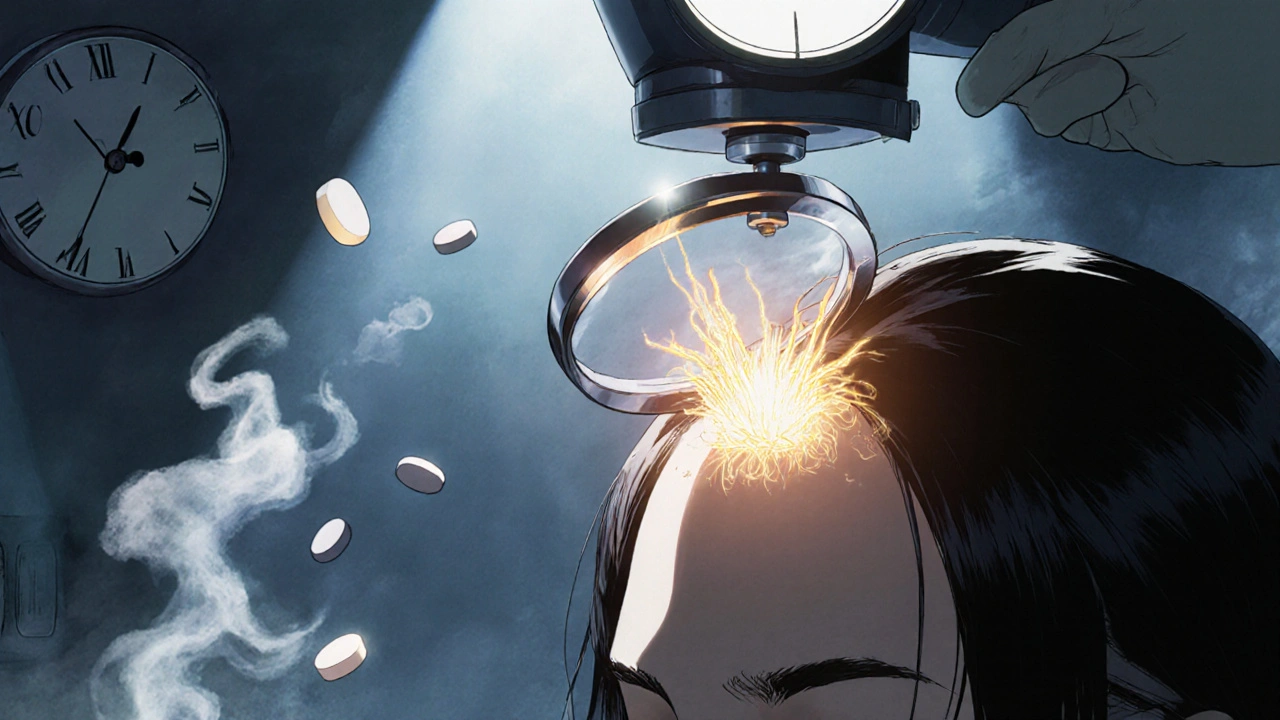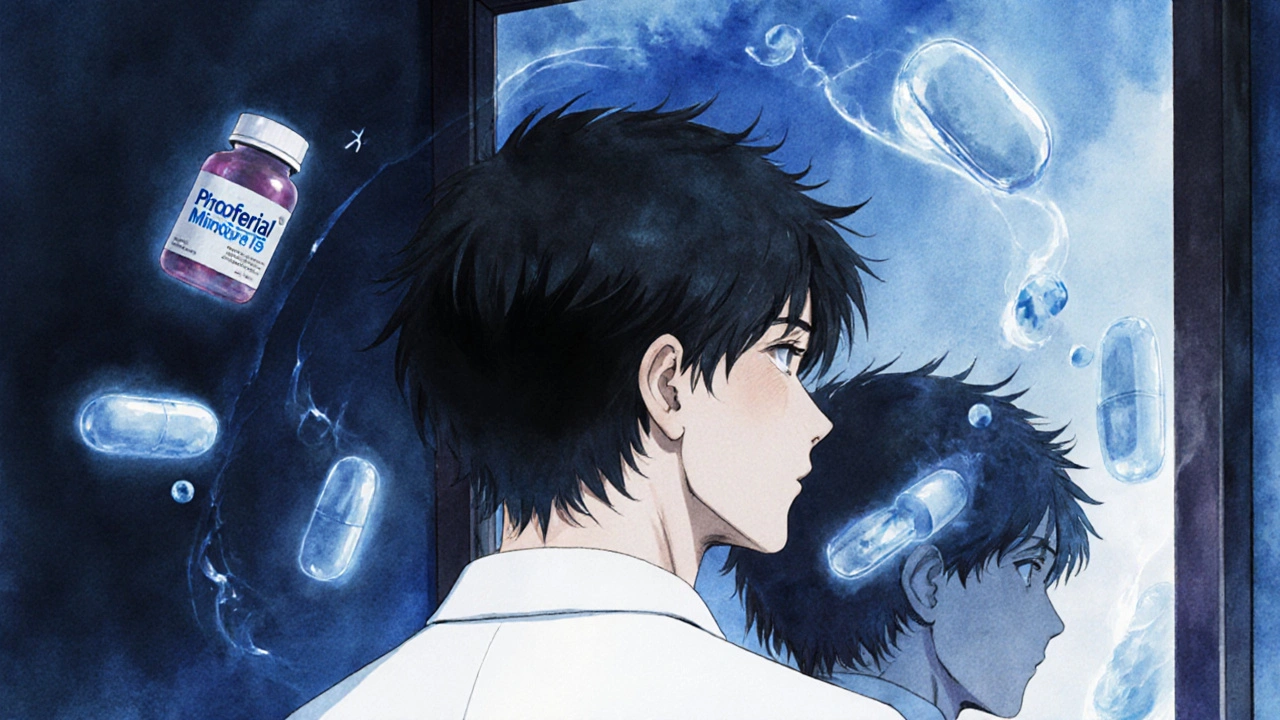Hair Loss Treatment Decision Guide
Propecia (finasteride) has been the go-to pill for male pattern baldness for over 20 years. But it’s not the only option anymore - and for many men, it’s not even the best one. If you’re wondering whether Propecia is worth the side effects, or if there’s something safer, stronger, or cheaper out there, you’re not alone. Thousands of men are switching. Here’s what actually works - and what doesn’t - when you compare Propecia to its top alternatives.
How Propecia Really Works
Propecia contains finasteride, a drug that blocks the enzyme 5-alpha-reductase. This enzyme turns testosterone into dihydrotestosterone (DHT), the hormone that shrinks hair follicles in men genetically prone to balding. By lowering DHT levels by about 70%, finasteride slows or stops hair loss in most men. In clinical trials, 83% of men taking 1mg daily maintained or regrew hair after two years. But here’s the catch: it only works as long as you keep taking it. Stop, and DHT levels bounce back - along with the hair loss.
Side effects aren’t rare. Around 1.8% of users report sexual side effects like lowered libido, erectile dysfunction, or reduced semen volume. These usually go away after stopping, but in rare cases, they persist. The FDA added a warning in 2011. Some men report brain fog or depression too. It’s not a risk-free pill.
Alternative #1: Minoxidil (Rogaine)
Minoxidil is the only FDA-approved topical treatment for hair loss. Unlike Propecia, it doesn’t touch hormones. Instead, it widens blood vessels in the scalp, boosting blood flow and nutrient delivery to follicles. It’s available as a 2% or 5% liquid or foam, applied twice daily.
Results? About 40% of men see moderate regrowth after four months. It works best on the crown, not the hairline. The downside? You have to use it forever. Miss a day or two, and shedding resumes. It also causes scalp itching, dryness, or flaking in up to 20% of users. Some men get facial hair growth by accident.
Here’s the real advantage: no systemic side effects. Minoxidil doesn’t affect testosterone, libido, or mood. It’s safe for men who can’t take finasteride. Many use it alongside Propecia - studies show better results together than either alone.
Alternative #2: Dutasteride (Avodart)
Dutasteride is the stronger cousin of finasteride. It blocks both types of 5-alpha-reductase enzymes, cutting DHT by 90-95%. That’s more than Propecia. In studies, dutasteride showed slightly better hair regrowth than finasteride after one year.
But it’s not FDA-approved for hair loss. Doctors prescribe it off-label. It’s also not sold under a brand name for this use - you get it as generic dutasteride, often in 0.5mg capsules. The dose for hair loss is usually 0.5mg every other day or 0.25mg daily.
The side effect profile is similar to finasteride, but some men report stronger sexual side effects. A 2021 study in the Journal of the American Academy of Dermatology found dutasteride users had a 2.5% higher risk of persistent sexual dysfunction than finasteride users. It’s more potent - but also more risky. Only consider it if finasteride failed you.
Alternative #3: Low-Level Laser Therapy (LLLT)
LLLT devices - caps, combs, or helmets - use red light to stimulate follicles. They’re non-drug, non-invasive, and FDA-cleared. The science is solid: a 2019 meta-analysis in Lasers in Surgery and Medicine showed LLLT increased hair density by 20% over 16 weeks.
Brands like Capillus, iRestore, and Theradome cost between $300 and $1,000. You use them 3-5 times a week for 20-30 minutes. Results take 3-6 months. No pills, no hormones, no side effects.
It’s not a miracle. It won’t regrow a receding hairline like a 20-year-old. But for men in the early stages of thinning, it’s a safe, effective maintenance tool. Many use it with minoxidil or after stopping finasteride to avoid rebound loss.

Alternative #4: Natural Supplements (Saw Palmetto, Pumpkin Seed Oil)
Saw palmetto is the most studied herbal option. It mildly inhibits 5-alpha-reductase - but not nearly as well as finasteride. A 2012 trial found saw palmetto extract improved hair count by 35% over six months - compared to 70% for finasteride. It’s not a replacement, but it’s a decent mild option.
Pumpkin seed oil has shown promise in small studies. One 2014 trial with 76 men found a 40% increase in hair count after 24 weeks using 400mg daily. The mechanism? Likely anti-androgenic effects.
These supplements are safe. No sexual side effects. But they’re not regulated like drugs. Quality varies wildly. You need to take them daily for months to see anything. Don’t expect miracles - but if you want a gentle, natural approach, they’re worth trying.
Alternative #5: Hair Transplants
If you’ve lost hair for years and medications haven’t worked, a transplant is the only way to get real, permanent hair back. Modern techniques like FUE (follicular unit extraction) remove individual hair follicles from the back of the head and implant them where you’re thinning.
Costs range from $4,000 to $15,000, depending on the number of grafts. Recovery takes about 10 days. Results appear slowly - new hair grows in 3-6 months, full results take a year.
Transplants don’t stop future hair loss. That’s why most men continue using finasteride or minoxidil after surgery to protect the remaining hair. It’s not a cure - it’s a restoration.
What Works Best? A Quick Comparison
| Treatment | Effectiveness | Time to Results | Side Effects | Cost (Annual) | Permanent? |
|---|---|---|---|---|---|
| Propecia (Finasteride) | High (70-80% stop loss) | 3-6 months | Sexual side effects in 1-2% | $30-$100 | No |
| Minoxidil (Rogaine) | Moderate (40% regrowth) | 4-6 months | Scalp irritation | $50-$80 | No |
| Dutasteride | Very High (85%+) | 3-6 months | Higher risk of sexual side effects | $50-$120 | No |
| LLLT (Laser Caps) | Mild to Moderate | 3-6 months | None | $300-$1,000 (one-time) | No |
| Saw Palmetto | Low to Moderate | 6+ months | Very low | $50-$100 | No |
| Hair Transplant | High (for transplanted hair) | 6-12 months | Surgery risks, scarring | $4,000-$15,000 (one-time) | Yes |

Who Should Try What?
If you’re young (20s-early 30s), just starting to thin, and want to stop hair loss before it gets bad - start with Propecia. It’s the most proven. But if you’re worried about side effects, try minoxidil first. It’s safer, and you can always add finasteride later.
If you’ve tried Propecia and it didn’t work - or you had side effects - move to dutasteride only under a doctor’s supervision. It’s stronger, but not safer.
If you hate pills, want zero hormone disruption, or are trying to conceive - go with LLLT or minoxidil. They’re hormone-free and safe.
If you’re in your 40s or 50s and have significant balding - consider a transplant. But don’t skip maintenance drugs afterward. The transplanted hair lasts - but your natural hair won’t.
If you want a natural, low-risk path - try saw palmetto and pumpkin seed oil. Don’t expect dramatic results, but you won’t risk your libido either.
Common Mistakes to Avoid
- Switching treatments too fast. Hair growth takes 6-12 months. Don’t quit after 2 months.
- Believing “natural” means “stronger.” Saw palmetto isn’t a substitute for finasteride.
- Using cheap, unregulated supplements. Look for standardized extracts with third-party testing.
- Skipping doctor visits. If you’re losing hair fast, get checked for thyroid issues, iron deficiency, or other causes.
- Thinking one treatment fixes everything. Most men need a combo - like minoxidil + LLLT, or finasteride + transplant.
Frequently Asked Questions
Is Propecia better than minoxidil?
Propecia stops hair loss more effectively than minoxidil, especially at the hairline. Minoxidil is better for regrowth on the crown. Many men use both together for the best results. Propecia works internally; minoxidil works topically. Neither is “better” - they do different things.
Can I take finasteride and dutasteride together?
No. Both drugs block the same enzyme. Taking them together doesn’t improve results - it only increases the risk of side effects. If finasteride isn’t working, switch to dutasteride, don’t stack them.
Do hair loss supplements really work?
Some, like saw palmetto and pumpkin seed oil, show modest results in small studies. But they’re far less effective than FDA-approved drugs. They’re best as a gentle backup - not a primary treatment. Don’t rely on them if you’re losing hair fast.
Will hair grow back after stopping Propecia?
No. Once you stop finasteride, DHT levels return to normal within days. Hair loss resumes within 6-12 months, often faster than before. The hair you gained will fall out. That’s why it’s a lifelong commitment - unless you switch to a permanent solution like a transplant.
Is laser therapy worth the money?
If you’re looking for a drug-free option and can afford the upfront cost, yes. Studies show real, measurable increases in hair density. It’s not as strong as finasteride, but it’s safe, easy to use, and works well with other treatments. Think of it as maintenance, not a cure.
Can women use Propecia or finasteride?
No. Finasteride is not approved for women and can cause birth defects. Women with hair loss should use minoxidil, spironolactone (under doctor supervision), or LLLT. Hormonal causes like PCOS or thyroid issues should be ruled out first.
Next Steps
Start by identifying your goal: Do you want to stop hair loss? Regrow hair? Avoid side effects? Save money? Each treatment has trade-offs. If you’re unsure, talk to a dermatologist who specializes in hair loss. They can check your hormone levels, scalp health, and family history to guide you.
Don’t rush. Most men try two or three options before finding what works. Keep track of your progress with monthly photos. Give each treatment at least 6 months. And remember - hair loss isn’t a race. It’s a long-term game. The best treatment is the one you can stick with - safely - for years to come.

William Priest
Propecia? Please. If you're still on finasteride in 2024, you're either stuck in 2008 or too lazy to research LLLT. I've been using a Theradome for 14 months-no pills, no drama, just steady growth. The science is solid, and your balls stay where they belong. Why are people still risking ED over a $100/month pill when a one-time $600 cap works better? 🤷♂️
Ryan Masuga
Man, I just started minoxidil last month and honestly? I'm already noticing less shedding. It’s been 6 weeks and my crown looks less see-through. I know it takes 6 months but I’m trying to stay patient. If anyone’s starting out, don’t quit after 2 weeks. I thought I was wasting money until week 5. Keep going.
Jennifer Bedrosian
Okay but like… why is everyone so obsessed with pills?? I tried saw palmetto because I was scared of side effects and now my beard is wild and my hair is… kinda not falling out as much?? I don’t know what’s happening but I’m not taking a pill that makes me feel like a zombie. Also my dog licked my scalp once and now he’s obsessed with it. Weird.
Lashonda Rene
I just want to say that everyone’s experience is different and that’s okay. I tried finasteride for six months and had brain fog so I switched to minoxidil and then added laser therapy and honestly I don’t care what the studies say, I feel better now. My hair isn’t perfect but I’m not crying in the shower every morning anymore. Sometimes the best treatment is the one that lets you sleep at night.
Andy Slack
Just got my Capillus cap last week. First week feels like a sci-fi movie. I sit there with red lights on my head like a robot. But I’m committed. No pills. No prescriptions. Just me, my laser helmet, and my cat judging me. If you’re thinking about it-just buy it. You’ll thank yourself in 6 months.
Rashmi Mohapatra
Why are Americans spending so much money on hair? In India we just shave it all and wear turbans. It’s cheaper, cleaner, and you don’t need 5 different products. Also, if you’re losing hair at 25, maybe stop stressing so much. Life is not a shampoo commercial.
Abigail Chrisma
As a woman who’s watched my brother go through this, I just want to say: be kind to yourself. Hair loss isn’t vanity-it’s identity. Whether you go with pills, lasers, or just embrace the bald look, what matters is you’re making a choice that fits your life. No one else gets to decide what ‘success’ looks like for you.
Ankit Yadav
My cousin took dutasteride after finasteride failed. He said the side effects were worse but the regrowth was noticeable. He’s now on 0.25mg every other day and says it’s manageable. Just make sure you get blood work done. Don’t just guess your dose. And talk to a real doctor-not Reddit.
Meghan Rose
Wait so if you stop finasteride your hair just falls out?? Like all of it?? That’s terrifying. I thought it just slowed down. So you’re basically trapped? Like forever? What if you want to have kids? What if you get depressed? What if you regret it? Why is this even legal??
Steve Phillips
Propecia? Minoxidil? LLLT? Please. You’re all missing the point. The REAL solution is a perfectly groomed bald head. No drugs. No devices. Just confidence. I went fully bald at 28. Now I get compliments on my ‘aesthetic’. You don’t need to fight biology-you need to upgrade your self-image. Also, I use coconut oil on my scalp. It’s cheaper than your minoxidil bottle. And yes, I’m a genius.
Rachel Puno
I started with saw palmetto, then added pumpkin seed oil, then got a laser comb. Took 8 months but I can finally see my part again. It’s slow but it’s real. Don’t compare yourself to guys on YouTube who say ‘grew back full head in 3 months’. That’s not real. Real growth is quiet. Keep going.
Clyde Verdin Jr
Propecia is a scam. The FDA knows it. The doctors know it. The pharma companies are laughing all the way to the bank. You’re paying $100 a month to delay the inevitable. Why not just shave it and get a cool tattoo? At least then you’re owning it. Also, your ‘natural supplements’ are just glorified pumpkin seeds. Grow up.
Key Davis
Thank you for this comprehensive, evidence-based overview. It is refreshing to encounter a discussion grounded in clinical data rather than anecdotal speculation. The comparative efficacy and safety profiles presented herein provide a valuable framework for informed decision-making. I would encourage all readers to consult with a board-certified dermatologist prior to initiating any therapeutic regimen, as individual physiological variables may significantly influence outcomes.